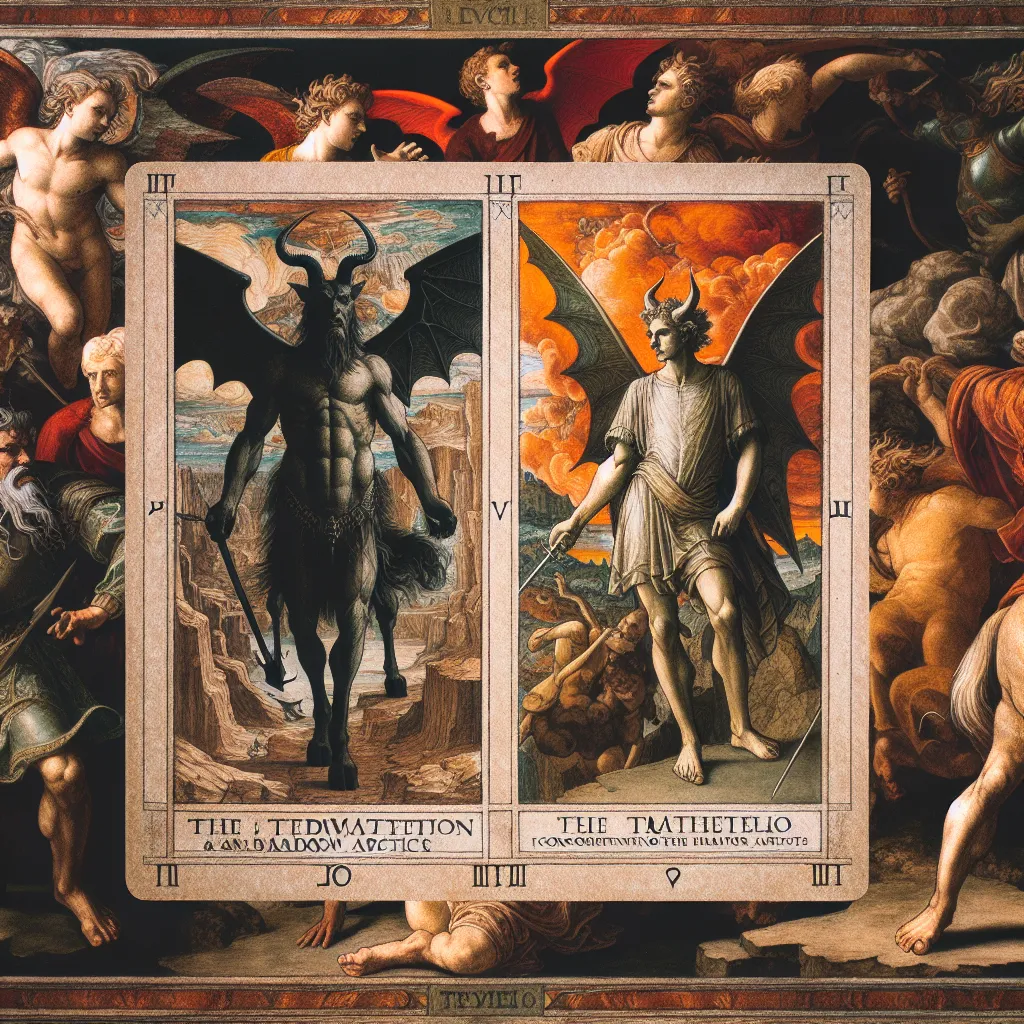
- Published on
- Authors

- Name
- You
The Devil Card: Confronting Temptation and Shadow Aspects
Tarot, a venerable divination tool, often arouses fascination with its rich symbolism and profound insights. Among its 78 cards, the Devil card stands out for its challenging themes. This card, often misunderstood, delves into the depths of human temptation and our darker, shadow self.
Symbolism of the Devil Card
The Devil card traditionally depicts a horned beast, often resembling the deity Pan or Baphomet. It sits enthroned, overseeing two chained figures. These figures represent the card's principal themes: temptation, materialism, and an entrapment of the spirit.
| Element | Symbolism |
|---|---|
| Horned Beast | Represents primal instincts, unrestrained animalistic desires |
| Chains | Symbolize the voluntary entrapment in materialism and excessive indulgences |
| Human Figures | Depict the subjugated conscious, being led by unchecked subconscious urges |
| Upside-Down Torch | Signifies an illumination of dark truths, a call to confront what we prefer to ignore |
Themes of Temptation
The Devil card invites us to explore the labyrinthine corridors of temptation. This is not a call to demonize natural desires but to seek a balanced relationship with them.
Key Concepts of Temptation:
- Materialism: Succumbing to the allure of material wealth and possessions, leading to spiritual neglect.
- Addiction: Manifesting in various forms—substance abuse, toxic relationships, or unhealthy habits—ensnares the free spirit.
- Power Dynamics: Yielding to unhealthy power structures, whether personal or professional, which can dominate our sense of self and actions.
Confronting the Shadow Self
Carl Jung proposed the concept of the 'Shadow'—an amalgamation of the aspects of ourselves we prefer to hide or deny. The Devil card compels us to confront this shadow. By doing so, we acknowledge and integrate these aspects, fostering a holistic sense of self.
Exercises for Shadow Work
- Journaling: Document thoughts and emotions that arise from daily experiences. Identify patterns and recurring thematics pertaining to fear or avoidance.
- Meditation: Engage in guided meditations focused on inner child work to reconnect with repressed emotions.
- Artistic Expression: Channeling the shadow through creative outlets like painting, music, or writing, allowing for sublimation of hidden energies.
Rituals and Practices
Integrating the Devil card into one's spiritual practices offers a comprehensive understanding of its messages.
The Mirror Ritual
- Setup: Light a black candle (for protection and absorption of negativity) and position a hand-held mirror facing you.
- Invocation: Speak an invocation to your higher self or spirit guides for protection and guidance.
- Reflection: Gaze into the mirror and allow your subconscious to surface. Pay attention to discomfort, as it denotes areas needing attention.
- Integration: Conclude by writing about the experience, focusing on the emotions and thoughts that emerged.
The Cleansing Bath
A ritual to cleanse oneself of excessive material entrapments and psychological weights.
Ingredients Needed:
- Epsom Salt
- Sage or Lavender Essential Oil
- A Black Tourmaline Crystal
- Fresh Rose Petals for symbolic self-love and purification
Steps:
- Draw a Bath: Dissolve the Epsom salt and add essential oils and rose petals.
- Intent Setting: Hold the Black Tourmaline and declare your intention to release material and psychological fetters.
- Soak: Relax in the bath for at least 20 minutes, visualizing the water drawing out negative energies.
Conclusion
The Devil card is not a harbinger of doom but a teacher guiding us to acknowledge and embrace our shadow. It challenges us to break free from the chains of materialism and temptation and integrate our fragmented parts to achieve inner wholeness. In doing so, it marks a significant step on the path to self-mastery and profound spiritual enlightenment.
